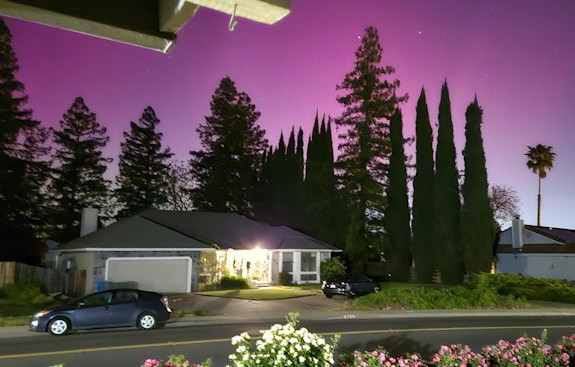 Science
Science
 Astronomy
Astronomy
 Solar Flares
Solar Flares
 Solar Flares & Sun Spots
Solar Flares & Sun Spots
Don's Home
 Science
Science
 Astronomy
Astronomy
 Solar Flares
Solar Flares
 Solar Flares & Sun Spots Solar Flares & Sun Spots
|

Northern Lights in Davis California, by Phyllis Seelye
It marks the first M5 geomagnetic storm to reach Earth since October 2003.
“The extreme geomagnetic storm continues and will persist through at least Sunday,” the National Oceanic Atmospheric Associate said on X.
It marks the first G5 geomagnetic storm to reach Earth since October 2003.
he Sun's activity waxes and wanes over an 11-year period known as the solar cycle,” the Solar Dynamics Observatory said on X. “Solar cycle 25 began in December 2019 and approches a solar maximum on May 11, 2024.
Phyllis Seelye got this picture in Davis just before midnight on Friday May 10, 2024.
On May 14, 2024, the Sun emitted a strong solar flare. This solar flare is the largest of Solar Cycle 25 and is classified as an X8.7 flare.
However the Northern Lights were not as intence as they were on the 10th because it was in a different area of the sun.
On May 14, 2024, the Sun emitted a strong solar flare. This solar flare is the largest of Solar Cycle 25 and is classified as an X8.7 flare. X-class denotes the most intense flares.
Largest Flare yet from Solar Cycle 25 on May 14. | Goddard Space Flight Center - NASA
How to observe the Northern lights:
Go to a dark area in the country to avoid light pollution.
It will still be vary faint to the naked eye, however modern phone cameras will take a much better picture in night mode.
This is because inside the human eye, there are two types of cells used for seeing. The “cone” cells are sensitive to colour but need plenty of light in order to function, whereas the “rods” cells are sensitive to low light levels but cannot distinguish colour.
Phones use CCD (Charge-Coupled Device) to detect light, which do not have this problem.
Most newer phones ( iPhone 11 and above, Samsung Galaxy S20 and above).
Explore the best camera settings for photographing the Northern Lights. | Adobe
Background:
The Northern Lights (Aurora Borealis) is caused by solar storms (increased magnetic activity on the sun)
The solar cycle, also known as the solar magnetic activity cycle, sunspot cycle, or Schwabe cycle, is a nearly periodic 11-year change in the Sun's activity measured in terms of variations in the number of observed sunspots on the Sun's surface.
Links:
Solar Cycle | Wikipedia
Why do the aurora look better through a camera? And how do you spot a fake image? Q&A with an astrophotographer
Explore the best camera settings for photographing the Northern Lights. | Adobe
What causes the Northern Lights? aurora-borealis-explained |